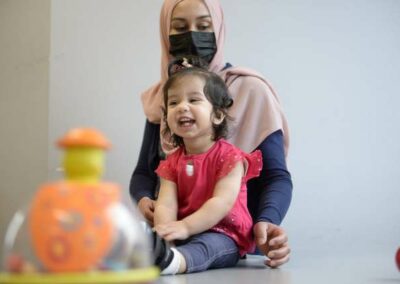She babbles in excitement every morning, grabbing whatever her hands find. With her incomplete set of teeth, she laughs out loud whenever she hears her name, Ayla. There is not much difference between her and other kids. But to her parents, everything she does, including the insignificant things, brings maximum happiness because their beloved daughter defiled all odds to stay alive. She is the first child treated as a fetus for Pompe disease, a rare genetic disorder.
Treating the fetus of Pompe disease
Doctors began treating the now 16-month-old Ayla Bashir in Ottawa, Canada, for Pompe disease while she was still a fetus. According to the team of doctors that handled the complex health challenge, the fetus was diagnosed with the disease and leaving the child to post-birth treatment could increase her chances of dying.
“The current patient received a diagnosis prenatally and was referred for inclusion in the newly launched phase 1 clinical trial of in-utero ERT,” the New England journal of medicine reported Wednesday.
The new form of treatment, still in a clinical trial, was used to the full to keep Ayla Bashir alive. According to the report, “Alglucosidase alfa (20 mg per kilogram of estimated fetal weight) was administered under ultrasonic guidance through the umbilical vein” The treatment began when the pregnancy or the fetus was 24 weeks. For every two weeks in the next 10 weeks, Ayla had to go for treatment even though she was still a fetus.
The treatment was administered by needle through the pregnant woman’s abdomen into her umbilical cord. To be sure that the medication has entered into the umbilical vein, a small volume of blood is drawn back at each infusion. The process, known as intrauterine therapy, is not a new procedure. It has been used for many years to treat fetuses of other ailments, but it was the first time doctors used it to treat Pompe disease.
Regarding the treatment, Dr Tippi MacKenzie, a pediatric and fetal surgeon from UCSF, said: “Enzyme replacement therapy is a new frontier in the field of fetal therapy; it has been exciting to see it grow from a research project in my laboratory to impact the outcome for this family ultimately.”
The treatment plan was developed by Dr Tippi MacKenzie, a pediatric surgeon at the University of California. However, Fung-Kee-Fung handled Ayla’s treatment, being the first person to use the procedure.
“It holds a glimmer of hope for being able to treat them in utero instead of waiting until the damage is already well-established,” Dr Karen Fung-Kee-Fung said.
Ayla, while still in her mother’s womb, received the treatment every two weeks, and in total, received six infusions or dosages until she was finally born in the summer of 2021.
“It was just a relief to have her in our arms and know she was OK,” Sobia Qureshi, Ayla’s mother, said.
It was also a remarkable birth to the family’s maternal doctors, Dr Karen Fung-Kee-Fung and Dr Pranesh Chakraborty, after witnessing both parents lost two children to the same disease.
Preventing the immune system from fighting back
The most challenging part of this procedure that kept Ayla alive, is the immune system. When the missing enzyme is injected into the fetus, the immune system sees it as strange and produces antibodies to destroy it. At least two babies did not make it through the procedure when it was first initiated.
For this reason, the team of medical experts considered suppressing the immune system so that it does not fight back should the missing enzyme be infused, hoping it would work this time.
Thankfully, the process worked, and that is why Ayla is alive.
Why treat a fetus when the child would come out someday?
Before developing the new procedure for treating the deadly Pompe disease, experts have tried treating babies immediately after they are diagnosed with the ailment sometime after their birth. However, it appears that waiting for the child to be born before beginning treatment could allow the deadly disease to cause irreversible damage.
The fetus treatment, although would not heal the patient, is the only method, at least for now, that can prevent the disease from damaging the heart and other parts of the body until the child is born. The fetus treatment is more of a preventive one.
Losing Zara and Sara before gaining Ayla
After Ayla was diagnosed with Pompe disease, her parents could only imagine if they were going to lose a child for the third time. Qureshi and Bashir’s two children have died from the same ailment.
The first of them was Zara, who was born in 2011. Until her birth, the couple said they have never heard of the rare genetic disease. When she was six months, Zara was confirmed to have been born with the ailment. Despite every effort by doctors to keep her alive with enzyme infusions, she died at the age of two and a half years. At the time of her death, Zara was unable to walk and talk.
Qureshi became pregnant again in 2016, and Like Ayla, the fetus was diagnosed with severe Pompe once again. This time, the couple made a tough decision to forgo enzyme therapy after Sara was born.







This is beautiful